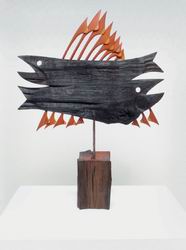Ivan Jančár
A retrospective exhibition of Václav Kautman (b. Brno on 25 September 1922; d. Bratislava, 24 September 1981) in ÚĽUV Gallery in Bratislava confirmed that the work of this extraordinary Slovak artist has not lost its topicality with the years. In the history of modern Slovak art, it is one of the unusual facts – a precious qualitative balance between utilitarian and free sculpture creation, precise work with material, appreciation of material and mass, and a totally concentrated perception of nature and life in total. Václav Kautman did not create only in the privacy of his studio but also persuaded many folk artists of their artistic mission. He both saved and enlivened many forgotten techniques, and later he passed on his experience to the students of the University of Fine Arts in Bratislava. The creations of Václav Kautman were especially communicative. He created several precisely designed utilitarian objects based in many aspects in folk tradition. Kautman also used the original folk techniques of wood processing – splitting, cutting, timbering, hollowing, metal inlaying, slotting, intarsia and brushing. While he turned, glued and burnt, he also did not hesitate to work with a chainsaw or milling machine. Many of his utilitarian objects were timeless, and their importance stretches beyond our own territory. He participated in an exhibition of Czechoslovak utilitarian art in Helsinki and Oslo, at the exhibition Form und Kvalität in Munich, at a world exhibition in Montreal, at exhibitions of Czechoslovak art in Novy Sad and London and many others. In his free statue creation, Václav Kautman was unique in our country. His statue creation in its clear simplicity, shape stylization and sense for a precisely shaped line in the best sense of the word developed the message of classical modern European sculpture. Kautman had, however, found his own unique and specific artistic expression. His fish, birds and many other animals display a specific handwriting, easily identified not just by artistic connoisseurs. He was able to create the most out of the least, and even with many variations of one topic each work has its own specific expression. His sculptural peak was reached in 1960s and 1970s. He did not need to create the great topics of that period but rather concentrated on perceiving nature. The same attention, however, he paid to creating motives of human figures. Here he does not seek perfection of beauty and shape but simplicity, and the shape of his figures are simple with deemphasized arms, legs or head. Whether from the utilitarian or free art side, many of Václav Kautman’s creations can only be dated with difficulty. This is due to the simple reason that they are timeless.
